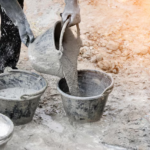Due to their distinct qualities, gravel and crushed stone can be used in various ways. Even though at first glance they can appear similar, each has distinct features and special purposes. Selecting the appropriate material for your project requires an understanding of these differences.
Crushed stone: what is it?
Artificial crushed stone is used as a construction aggregate. It is usually made by mining a suitable rock deposit and using crushers to reduce the extracted rock to the required size. Its rough texture and sharp edges distinguish it, and it is frequently composed of granite, limestone, or trap rock.
Key Characteristics:
- Created by breaking up more enormous boulders, this is artificial.
- The crushing process gives an angular shape with sharp edges.
- Available in a range of sizes, from considerable stones to fine dust.
What is Gravel?
Gravel is a natural material derived from riverbeds and glacial deposits. It is made up of loose rock pieces eroded over time by water and the elements. Gravel’s homogeneous texture and smooth, rounded edges define it.
Key Characteristics:
- Natural Origin: Taken from glacial deposits or riverbeds.
- Rounded Shape: Naturally weathered edges that are smooth.
- Consistent Texture: It typically has a more uniform texture than crushed stone.
Critical Differences Between Crushed Stone and Gravel
Formation Process
- Crushed Stone: Created through a mechanical process of crushing larger rocks.
- Gravel: Formed naturally through erosion and weathering.
Shape and Texture
- Crushed Stone: Angular and rough, which provides better interlocking properties.
- Gravel: Smooth and rounded, which makes it easier to work with in specific applications.
Composition
- Crushed Stone: Often made from granite, limestone, or trap rock.
- Gravel: Typically composed of various rock types, depending on the source.
Cost
- Crushed Stone: Generally more expensive due to the manufacturing process.
- Gravel: Often less costly because it is naturally occurring and requires less processing.
Uses of Crushed Stone and Gravel
Crushed Stone
- Road Base and Construction Fill: Crushed stone’s angular shape offers superior stability and drainage capabilities, which makes it perfect for these applications.
- Concrete and Asphalt Mix: Contributes strength and durability to concrete and asphalt as an aggregate.
- Because of its aesthetic appeal and practical qualities, landscaping is used in gardens and walkways.
Gravel
- gravel is a good material for roads and paths because of its smooth texture, which makes it easy to walk on.
- Drainage Systems: Because gravel lets water pass through readily, it’s frequently used in drainage systems.
- Landscaping: Offers a natural appearance and is perfect for ornamental gardens and landscapes.
By comprehending these essential variations and applications, you can select the ideal material for your upcoming building or landscaping project, guaranteeing practicality and visual beauty.
If you still have questions, Buildify- quality stone aggregate suppliers in Gurgaon can assist you with all of your construction-related inquiries over the phone!


